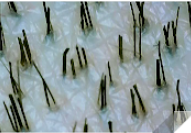I have published an article recently in the Hair Transplant Forum International (an industry newsletter, see below) that warns of doctors who perform Follicular Unit Extraction and produce a Follicular Holocaust, killing off many of the hair follicles and then charging the patient as if all of the follicles were actually transplanted. This process is unfortunately more the rule rather than the exception, because doctors just do not count what they actually deliver. This is a double ‘insult’ to the patient who pays for 100% of what the doctor says he is transferring and actually receiving something in the order of 25-50% of that quantity. The second part of the insult is the loss of the hair which may be irretrievably lost from the patient’s limited donor supply for life. So, the surgeons who engage in this process are cheating the patient and at the same time destroying valuable donor hair.
I have just participated in a Regional Workshop for the International Society for Hair Restoration Surgeons where I was one of the faculty, teaching the FUE technique on patient volunteers to some 25 doctors from around the world. A few of the better known self promoted doctors were invited to attend, but they did not take up the invitation. Most of the doctors who attended the course came with an open mind to learn state of the art FUE technology from more experienced physicians who have been doing FUE successfully for years. I learned that the reports of dishonesty that I reported in the article I wrote continue to be a real problem. I received confirmation of what I discussed in the article, which appears to be widespread, over much of the world. I applaud doctors who take formal approved courses to learn or enhance their skills for new technologies by spending the time and the money to come from Korea, Japan, Western and Eastern Europe, North America and the Middle East, but I continue to be disgusted by physicians who would rather develop experience by experimenting on patients and damaging/cheating fellow human beings. I admire the courageous balding people who want to get the benefits of new technologies, but when dishonest doctors promote their expertise with no real basis, they behave like hucksters, only distinguishing themselves from other crooks selling products or services by having an M.D. after their name and a ‘doctor’ for a title. Clearly, for the FUE buyer, the buyer must beware!
Here is the editorial I wrote addressing problems of ethics in hair transplantation surgery, which was published a few months ago in the Hair Transplant Forum International, January/February 2006, Volume 16, Number 1:

